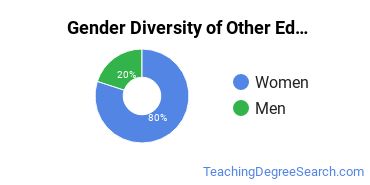Other Education at Caribbean University - Bayamon
If you plan to study other education, take a look at what Caribbean University - Bayamon has to offer and decide if the program is a good match for you. Get started with the following essential facts.Caribbean University - Bayamon is located in Bayamon, Puerto Rico and has a total student population of 987.
Want to know more about the career opportunities in this field? Check out the Careers in Other Education section at the bottom of this page.
Caribbean University - Bayamon Other Education Degrees Available
- Master’s Degree in Other Education
Caribbean University - Bayamon Other Education Rankings
Other Education Student Demographics at Caribbean University - Bayamon
Take a look at the following statistics related to the make-up of the other education majors at Caribbean University - Bayamon.
Caribbean University - Bayamon Other Education Master’s Program

In the other education master's program at this school, racial-ethnic minorities make up 100% of degree recipients. That is 63% better than the national average.*
The following table and chart show the race/ethnicity for students who recently graduated from Caribbean University - Bayamon with a master's in other education.

| Race/Ethnicity | Number of Students |
|---|---|
| Asian | 0 |
| Black or African American | 0 |
| Hispanic or Latino | 4 |
| White | 0 |
| International Students | 0 |
| Other Races/Ethnicities | 0 |
Concentrations Within Other Education
Other Education majors may want to concentrate their studies in one of these areas. The completion numbers here include all graduates who receive any type of degree in this field from Caribbean University - Bayamon. Some of these focus areas may not be available for your degree level.
| Concentration | Annual Degrees Awarded |
|---|---|
| Other Education | 10 |
Related Majors
- Instructional Media Design
- Teacher Education Grade Specific
- Teacher Education Subject Specific
- Educational Administration
- Special Education
References
*The racial-ethnic minorities count is calculated by taking the total number of students and subtracting white students, international students, and students whose race/ethnicity was unknown. This number is then divided by the total number of students at the school to obtain the racial-ethnic minorities percentage.
More about our data sources and methodologies.
